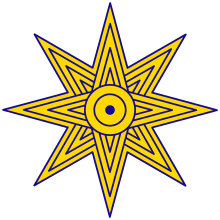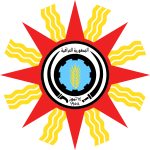166:
151:
71:
27:
497:
96:
counterpart. It seems to have originally borne a general association with the heavens, but, by the Old
Babylonian Period, it had come to be specifically associated with the planet Venus, with which Ishtar was identified. Starting during this same period, the star of Ishtar was normally enclosed
92:, though the exact number of points sometimes varies. Six-pointed stars also occur frequently, but their symbolic meaning is unknown. The eight-pointed star was Inanna's most common symbol, and in later times became the most common symbol of the goddess Ishtar, Inanna's
131:
was another important symbol of Ishtar which had originally belonged to Inanna. During the Neo-Assyrian Period, the rosette may have actually eclipsed the eight-pointed star and become Ishtar's primary symbol. The temple of Ishtar in the city of
165:
150:
383:
100:
During later times, slaves who worked in Ishtar's temples were sometimes branded with the seal of the eight-pointed star. On
481:
521:
445:
516:
501:
546:
207:). The stars of Ishtar and Shamash featured on the coat of arms of the Kingdom of Iraq from 1932 to 1959.
526:
541:
531:
422:
Amatzia Baram, "Mesopotamian
Identity in Ba'thi Iraq," Middle Eastern Studies, Oct. 1983, p. 427.
405:
219:
197:
536:
8:
172:
89:
58:
was also one of Ishtar's primary symbols. Ishtar is mostly associated with the planet
477:
441:
70:
375:
128:
551:
247:
231:
210:
A simplified version with red rays and a yellow centre was incorporated into the
188:
113:
105:
81:
510:
252:
211:
156:
117:
93:
438:
Gods, Demons and
Symbols of Ancient Mesopotamia: An Illustrated Dictionary
262:
133:
214:
from 1959 to 1963. It also featured in a combination with the sun of
26:
454:
Collins, Paul (1994), "The
Sumerian Goddess Inanna (3400-2200 BC)",
19:
For the similar and often accompanying star symbol for the Sun, see
242:
109:
215:
176:
121:
101:
76:
496:
286:
284:
282:
280:
278:
257:
236:
51:
47:
328:
59:
43:
355:
275:
345:
343:
318:
316:
314:
108:, the eight-pointed star is sometimes shown alongside the
301:
299:
55:
20:
340:
311:
296:
474:
Symbols: Encyclopedia of
Western Signs and Ideograms
202:
462:
376:"The First Banknotes of the Central Bank of Iraq"
334:
508:
467:, Jewish Institute of Religion Press, p. 81
159:1959–1963 with the star of Ishtar in the middle
171:Emblem of Iraq 1959-1965, during nationalist
74:Depiction of the star of Ishtar (left) on a
456:Papers of from the Institute of Archaeology
179:and Ishtar, and avoided pan-Arab symbolism.
62:, which is also known as the morning star.
463:Gressmann, Hugo; Obermann, Julian (1928),
435:
361:
349:
322:
290:
471:
305:
69:
42:is a Mesopotamian symbol of the ancient
25:
453:
403:
509:
436:Black, Jeremy; Green, Anthony (1992),
373:
16:Symbol of the Sumerian goddess Inanna
136:was adorned with numerous rosettes.
476:, Lidingö, Sweden: HME Publishing,
192:
187:In Arabic, the symbol is known as (
13:
175:, based on the ancient symbols of
14:
563:
490:
116:, god of the Moon, and the rayed
50:and her East Semitic counterpart
495:
164:
149:
429:
404:Dawisha, Adeed (January 2003).
386:from the original on 2023-06-20
139:
88:The star of Inanna usually had
416:
406:"Requiem for Arab Nationalism"
397:
367:
1:
335:Gressmann & Obermann 1928
268:
440:, The British Museum Press,
7:
374:Symes, Peter (March 2005).
225:
203:
10:
568:
472:Liungman, Carl G. (2004),
112:, which was the symbol of
65:
18:
522:National symbols of Iraq
120:, which was a symbol of
97:within a circular disc.
220:national emblem of Iraq
517:Mesopotamian mythology
362:Black & Green 1992
350:Black & Green 1992
323:Black & Green 1992
291:Black & Green 1992
124:, the god of the Sun.
85:
31:
504:at Wikimedia Commons
410:Middle East Quarterly
73:
29:
547:History of astrology
364:, pp. 156–157.
293:, pp. 169–170.
222:from 1959 to 1965.
465:The Tower of Babel
458:, vol. 5, UCL
380:www.pjsymes.com.au
86:
32:
527:Religious symbols
500:Media related to
201:
84:(12th century BC)
559:
542:Heraldic charges
532:Venus in culture
499:
486:
468:
459:
450:
423:
420:
414:
413:
401:
395:
394:
392:
391:
371:
365:
359:
353:
347:
338:
332:
326:
320:
309:
303:
294:
288:
206:
196:
194:
168:
153:
567:
566:
562:
561:
560:
558:
557:
556:
507:
506:
493:
484:
448:
432:
427:
426:
421:
417:
402:
398:
389:
387:
372:
368:
360:
356:
348:
341:
333:
329:
321:
312:
304:
297:
289:
276:
271:
248:Star of Lakshmi
232:Lion of Babylon
228:
185:
184:
183:
180:
169:
160:
154:
142:
102:boundary stones
68:
24:
17:
12:
11:
5:
565:
555:
554:
549:
544:
539:
534:
529:
524:
519:
502:Star of Ishtar
492:
491:External links
489:
488:
487:
483:978-9197270502
482:
469:
460:
451:
446:
431:
428:
425:
424:
415:
396:
366:
354:
352:, p. 156.
339:
327:
325:, p. 170.
310:
308:, p. 228.
295:
273:
272:
270:
267:
266:
265:
260:
255:
250:
245:
240:
234:
227:
224:
182:
181:
170:
163:
161:
155:
148:
145:
144:
143:
141:
138:
106:cylinder seals
82:Meli-Shipak II
67:
64:
40:Star of Inanna
36:Star of Ishtar
30:Star of Ishtar
15:
9:
6:
4:
3:
2:
564:
553:
550:
548:
545:
543:
540:
538:
535:
533:
530:
528:
525:
523:
520:
518:
515:
514:
512:
505:
503:
498:
485:
479:
475:
470:
466:
461:
457:
452:
449:
447:0-7141-1705-6
443:
439:
434:
433:
419:
411:
407:
400:
385:
381:
377:
370:
363:
358:
351:
346:
344:
337:, p. 81.
336:
331:
324:
319:
317:
315:
307:
306:Liungman 2004
302:
300:
292:
287:
285:
283:
281:
279:
274:
264:
261:
259:
256:
254:
251:
249:
246:
244:
241:
238:
235:
233:
230:
229:
223:
221:
217:
213:
208:
205:
204:najmat eshtar
199:
190:
178:
174:
167:
162:
158:
152:
147:
146:
137:
135:
130:
125:
123:
119:
115:
111:
110:crescent moon
107:
103:
98:
95:
91:
83:
79:
78:
72:
63:
61:
57:
53:
49:
45:
41:
37:
28:
22:
537:Star symbols
494:
473:
464:
455:
437:
430:Bibliography
418:
409:
399:
388:. Retrieved
379:
369:
357:
330:
253:Kagome crest
212:flag of Iraq
209:
186:
157:Flag of Iraq
140:Flag of Iraq
126:
99:
94:East Semitic
90:eight points
87:
75:
39:
35:
33:
263:Rub el Hizb
511:Categories
390:2023-06-20
269:References
193:نجمة عشتار
118:solar disk
198:romanized
384:Archived
243:Octagram
226:See also
46:goddess
44:Sumerian
218:on the
216:Shamash
200::
177:Shamash
129:rosette
122:Shamash
77:kudurru
66:History
552:Inanna
480:
444:
258:Shamsa
237:Dingir
189:Arabic
54:. The
52:Ishtar
48:Inanna
173:Qasim
134:Aššur
60:Venus
478:ISBN
442:ISBN
239:⟨𒀭⟩
127:The
104:and
34:The
114:Sin
80:of
56:owl
38:or
21:Utu
513::
408:.
382:.
378:.
342:^
313:^
298:^
277:^
195:,
191::
412:.
393:.
23:.
Text is available under the Creative Commons Attribution-ShareAlike License. Additional terms may apply.



